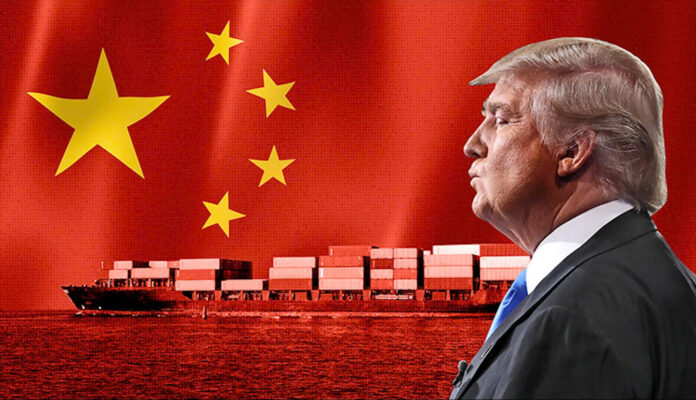Cunning Ploy – Can China Outsmart Trump’s Tariff Trap?
OPINION: This article may contain commentary which reflects the author's opinion.

On April 9, 2025, the global trade war took a dramatic turn when President Donald Trump announced a 90-day pause on “reciprocal” tariffs for 75 nations—everyone except China, which got slapped with a staggering 125% tariff hike. The move, coming after a market meltdown that saw Wall Street lose $2.5 trillion in value (The Guardian, April 3), sent the S&P 500 soaring 9.5% in a single day, the biggest jump since 2008. But while the world exhaled, a cunning ploy emerged: Trump’s tariff trap might just be handing China a golden opportunity to outsmart him. By rerouting goods through smaller nations, China could dodge the tariff wall, turning Trump’s hardline stance into a hollow victory. Is Beijing about to flip the script on the trade war? Let’s dive in.
First, the backdrop. Trump’s second term kicked off with a tariff blitz dubbed “Liberation Day.” By late March, he’d rolled out rates from 10% on all imports to 104% on Chinese goods, 20% on the EU, 24% on Japan, and 46% on Vietnam. The goal? Slash America’s $918 billion trade deficit (2024 Census Bureau data) and “stop the looting,” as Trump put it. Markets panicked—Dow down 4%, Nasdaq 6%, the dollar sliding 2.2% to a six-month low. China fired back with an 84% tax on U.S. goods, and the EU prepped retaliation. Then, on April 9, Trump hit pause—90 days of relief for all but China, whose tariff jumped to 125% for “disrespecting global markets,” per Reuters. Trump’s quip? “People were getting a little yippee, so I put a pause—but nothing’s over yet.”
The pause was a lifeline for markets, but it’s a head-scratcher for China policy. Why single out Beijing while giving everyone else a breather? Trump’s team, led by Treasury Secretary Scott Bessent, says it’s leverage: 75 nations are now “at the table,” ready to negotiate, while China’s “unwillingness to talk” justifies the squeeze. On X, trade hawks cheer—“Isolate China, win the war!”—but others see a flaw: this could backfire, big time. China’s no stranger to dodging tariffs, and Trump’s pause might just be the opening they need to outmaneuver him.
Here’s how China could outsmart the tariff trap: rerouting through smaller nations. For years, Chinese firms have shifted supply chains to skirt U.S. tariffs. During Trump’s first term, goods flowed through Vietnam, Mexico, and Thailand—repackaged, relabeled, or minimally processed to qualify as “non-Chinese.” A 2023 U.S. International Trade Commission report found that 30% of Vietnam’s exports to the U.S. in 2020 were Chinese-origin goods in disguise. Now, with Trump’s 90-day pause dropping tariffs to 10% for nations like Vietnam (down from 46%), the incentive to reroute is sky-high. Why pay 125% to ship directly from Shanghai when you can funnel through Hanoi at 10%?
Picture this: a container of Chinese electronics sails to Vietnam, gets a “Made in Vietnam” stamp after minor assembly, and enters the U.S. at the lower rate. Or steel from Beijing gets melted and recast in Thailand, dodging the China tariff entirely. The New York Times (April 8, 2025) notes Trump recently closed a loophole letting low-value Chinese packages enter duty-free, but that doesn’t touch transshipment. On X, a supply chain analyst posted, “China’s already rerouting—Vietnam’s ports are slammed.” Data backs this: Vietnam’s exports to the U.S. spiked 25% in Q1 2025, per Vietnam Customs, a sign the game’s already on.
Trump’s team isn’t blind to this. The 125% tariff aims to make direct Chinese imports unprofitable, even with rerouting costs. But here’s the rub: the pause for other nations undercuts that pressure. At 10%, the math works for China—ship to a third country, pay a small fee, and still undercut the 125% hit. Plus, smaller nations benefit: Vietnam, Thailand, and Mexico get a cut as middlemen, boosting their economies while China keeps selling. It’s a win-win for everyone but Trump, whose tariff trap might end up trapping… nobody.
So, why the pause if it risks this loophole? Trump’s likely playing a multi-level game. First, he’s buying time. The market crash—4% off the Dow—rattled him. He’s bragged about stock highs since 2017; a bear market in 2025 would bruise his ego and his 2026 midterm chances. The 9.5% S&P jump post-pause bought him breathing room, maybe even a Fed rate cut by June (odds of holding steady fell to 25%, per futures markets). Second, he’s rallying allies. By sparing the EU, Japan, and others, he’s building a coalition to pressure China—divide and conquer. Bessent told CNBC on April 9, “China’s isolated now—they’ll come crawling back.” Third, he’s flexing for the base. Targeting China with 125% plays to his “America First” crowd, who see Beijing as the ultimate trade villain.
But China’s not crawling—they’re scheming. Beyond rerouting, they’re retaliating. That 84% tariff on U.S. goods hits hard—think soybeans, Boeing jets, iPhones. If the EU joins in (they’re mulling 20% on U.S. oranges, jeans, Harleys), supply chains buckle, inflation spikes past 5%, and Oxford Economics’ 2026 recession warning (GDP down two quarters) looms. China’s also got leverage: rare earths, chips, batteries. A full export ban could cripple U.S. tech—Apple’s stock dipped 3% on April 9 at the mere rumor. On X, a Beijing-based economist posted, “China’s playing the long game—Trump’s pause is our window.”
Can Trump counter this? He’d need to tighten rules on country-of-origin labeling—something U.S. Customs struggles with, per a 2024 GAO report. He could also sanction third countries, but that risks alienating allies he’s courting. Or he could double down—hike tariffs on Vietnam if transshipment spikes. But that’d reignite the trade war he just paused, tanking markets again. He’s in a bind: let China slip through, or risk a broader fight.
What’s next? The 90-day clock ends July 8. If China ramps up rerouting—say, Vietnam’s U.S. exports jump another 20%—Trump’s tariff trap fails. If he cracks down, he might salvage his strategy but lose the coalition. Markets hang in the balance: S&P could hit 6,000 by year-end if deals are struck, or crash 10-20% if retaliation spirals, per Barclays. China’s outsmarting him so far, but Trump’s got a knack for surprises.
Is this cunning ploy a trade war checkmate? China’s dodging, Trump’s plotting, and the world’s watching. Want to know how Beijing’s sneaking past—and what Trump might do next? Click here to uncover every twist, every tactic, every secret in this high-stakes showdown!



